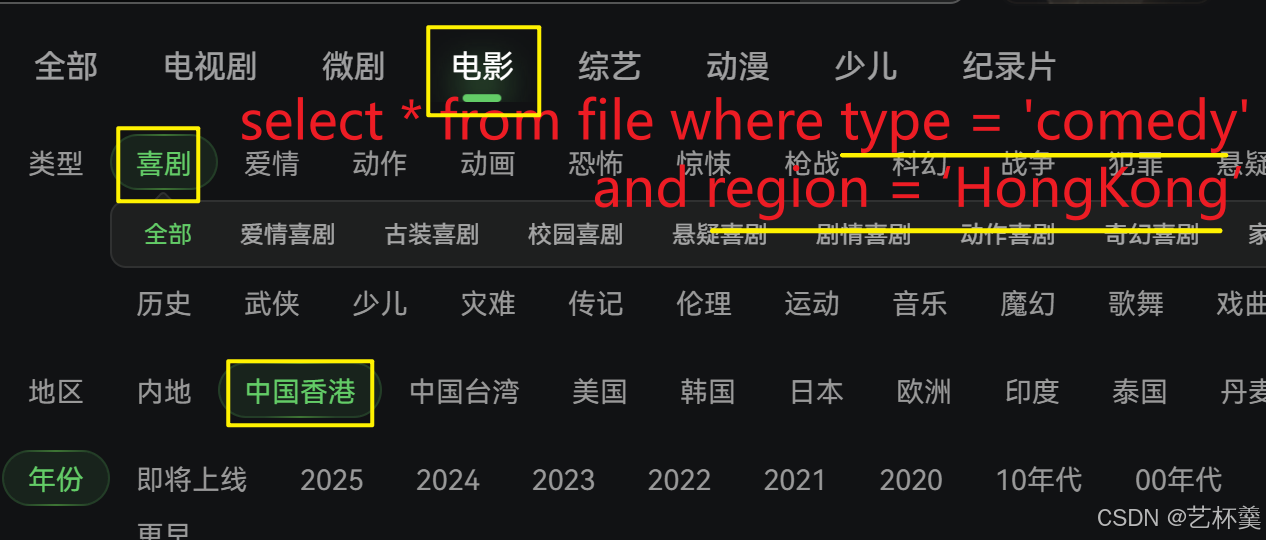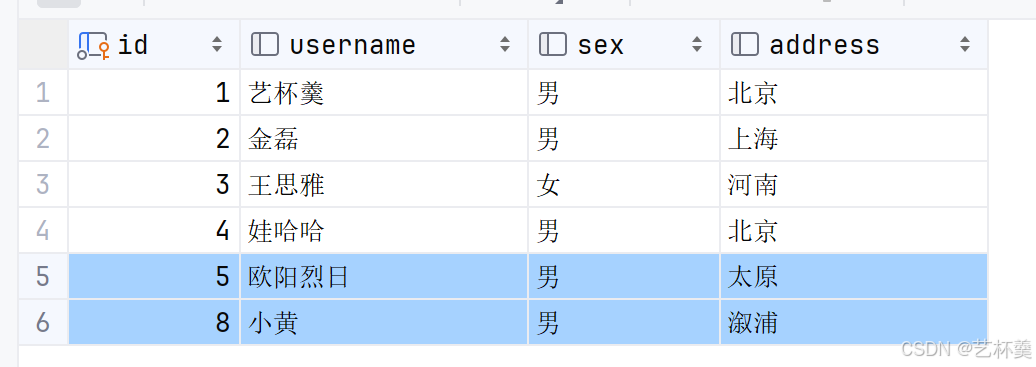目录
[1. 动态SQL](#1. 动态SQL)
[1.1. if](#1.1. if)
[1.1.1. 持久层接口添加方法](#1.1.1. 持久层接口添加方法)
[1.1.2. 映射文件添加标签](#1.1.2. 映射文件添加标签)
[1.1.3. 编写测试方法](#1.1.3. 编写测试方法)
[1.2. where](#1.2. where)
[1.3. set](#1.3. set)
[1.4. choose、when、otherwise](#1.4. choose、when、otherwise)
[1.5. foreach](#1.5. foreach)
[1.5.1. 遍历数组](#1.5.1. 遍历数组)
[1.5.2. 遍历Collection](#1.5.2. 遍历Collection)
[1.5.3. 遍历Map](#1.5.3. 遍历Map)
[2. 总结](#2. 总结)
前言
本文来讲解MyBatis的动态SQL
集合代码和图片演示,旨在让大家更好的理解(๑•̀ㅂ•́)و✧
个人主页:艺杯羹🌿
1. 动态SQL
一个查询的方法的Sql语句不一定是固定的
比如电影选片,根据不同要求,Sql语句就会添加不同的查询条件
如图:


此时就需要在方法中使用动态Sql语句
1.1. if
<if>标签内的Sql片段在满足条件后才会添加,用法为:<if test="条件">。例如:根据不同条件查询用户:
1.1.1. 持久层接口添加方法
java
// 用户通用查询
List<User> findByCondition(User user);1.1.2. 映射文件添加标签
XML
<select id="findByCondition" parameterType="com.yibeigen.pojo.User" resultType="com.itbaizhan.pojo.User">
select * from user where 1 = 1
<if test = "username != null and username.length() != 0">
and username like #{username}
</if>
<if test = "sex != null and sex.length() != 0">
and sex = #{sex}
</if>
<if test="address != null and address.length() != 0">
and address = #{address}
</if>
</select>1.1.3. 编写测试方法
java
@Test
public void testFindByCondition(){
User user = new User();
List<User> users1 = userMapper2.findByCondition(user);
//users1.forEach(System.out::println);
user.setUsername("%金%");
List<User> users2 = userMapper2.findByCondition(user);
users2.forEach(System.out::println);
user.setAddress("北京");
List<User> users3 = userMapper2.findByCondition(user);
users3.forEach(System.out::println);
}- if中的条件不能使用 && / ||,而应该使用 and / or
- if中的条件可以直接通过属性名获取参数POJO的属性值,并且该值可以调用方法。
- where后为什么要加1=1?
任意条件都可能拼接到Sql中。如果有多个条件,从第二个条件开始前都需要加And关键字。加上1=1这个永久成立的条件,就不需要考虑后面的条件哪个是第一个条件,后面的条件前都加And关键字即可
1.2. where
<where>可以代替sql中的 where 1=1 和 第一个and
更符合程序员的开发习惯,使用<where>后的映射文件如下:
if 标签放在 where 里
XML
<select id="findByCondition" resultType="com.itbaizhan.user.User" parameterType="com.itbaizhan.user.User">
select * from user
<where>
<if test="username != null and username.length() != 0">
username like #{username}
</if>
<if test="sex != null and sex.length() != 0">
and sex = #{sex}
</if>
</where>
</select>1.3. set
<set>标签用在update语句中
借助<if>,可以只对有具体值的字段进行更新
<set>会自动添加set关键字,并去掉最后一个if语句中多余的逗号
XML
<update id="update" parameterType="com.yibeigen.user.User">
update user
<set>
<if test="username != null and username.length() > 0">
username = #{username},
</if>
<if test="sex != null and sex.length() > 0">
sex = #{sex},
</if>
</set>
<where>
id = #{id}
</where>
</update>1.4. choose、when、otherwise
这些标签表示多条件分支,类似JAVA中的switch...case
<choose>类似switch
<when>类似case
<otherwise>类似default
用法如下:
XML
<select id="findByCondition" resultType="com.yibeigen.user.User" parameterType="com.yibeigen.user.User">
select * from user
<where>
<choose>
<when test="username.length() < 5">
username like #{username}
</when>
<when test="username.length() < 10">
username = #{username}
</when>
<otherwise>
id = 1
</otherwise>
</choose>
</where>
</select>这段代码的含义为:
用户名 < 5 时使用 模糊查询
用户名 >= 5 并且 < 10 时使用 精确查询
否则查询id为1的用户
1.5. foreach
<foreach>类似 JAVA 中的for循环,可以遍历集合或数组。<foreach>有如下属性:
- collection:遍历的对象类型
- open:开始的sql语句
- close:结束的sql语句
- separator:遍历每项间的分隔符
- item:表示本次遍历获取的元素,遍历List、Set、数组时表示每项元素,遍历map时表示键值对的值
- index:遍历List、数组时表示遍历的索引,遍历map时表示键值对的键
1.5.1. 遍历数组
我们使用<foreach>遍历数组进行批量删除
- 持久层接口添加方法
java
void deleteBatch(int[] ids);- 映射文件添加标签
XML
<delete id="deleteBatch" parameterType="int">
delete from user
<where>
<foreach open="id in(" close=")" separator="," collection="array" item="id" >
#{id}
</foreach>
</where>
</delete>- 编写测试方法
java
@Test
public void testDeleteBatch(){
int[] ids = {5,8};
userMapper.deleteBatch(ids);
session.commit();
}


1.5.2. 遍历Collection
<foreach>遍历List和Set的方法是一样的,我们使用<foreach>遍历List进行批量添加。
- 持久层接口添加方法
java
void insertBatch(List<User> users);- 映射文件添加标签
XML
<insert id="insertBatch" parameterType="com.yibeigen.user.User">
insert into user values
<foreach collection="list" item="user" separator=",">
(null ,#{user.username},#{user.birthday},#{user.sex},#{user.address})
</foreach>
</insert>- 编写测试方法
java
@Test
public void testInsertBatch(){
User user1 = new User("程序员1", "男", "北京");
User user2 = new User("程序员2", "女", "上海");
List<User> users = new ArrayList();
users.add(user1);
users.add(user2);
userMapper2.insertBatch(users);
session.commit();
}
1.5.3. 遍历Map
我们使用<foreach>遍历Map进行多条件查询
- 持久层接口添加方法
java
/**
* 多条件查询
* @param map 查询的条件键值对 键:属性名 值:属性值
* @return
要给参数起一个参数名才能用!!!
*/
List<User> findUser(@Param("queryMap") Map<String,Object> map);- 映射文件添加标签
XML
<select id="findUser" parameterType="map" resultType="com.yibeigen.pojo.User">
select * from user
<where>
<foreach collection="queryMap" separator="and" index="key" item="value">
-- 键是拼进来的,这个key和value是到时候会传进来的!!!
-- ${} 是直接会加上的,#{},是会预编译的
${key} = #{value}
</foreach>
</where>
</select>- 编写测试方法
java
@Test
public void testFileUser(){
Map<String, Object> queryMap = new HashMap<>();
queryMap.put("sex", "男");
queryMap.put("address", "北京");
List<User> user = userMapper.findUser(queryMap);
user.forEach(System.out::println);
}2. 总结

现在就讲解完了动态SQL,希望对你有所帮助(๑•̀ㅂ•́)و✧